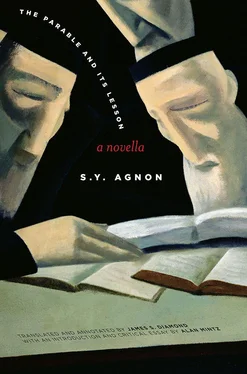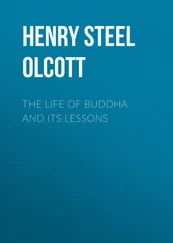MASHAL AS DECOY
In accounting for the meaning of a literary text, we usually take the privileged status of the work’s title as axiomatic. We assume that in fashioning a title an author is choosing an evocative phrase that stands for the work as a whole and pointing us in the direction of its main thematic import. In the story before us, Agnon would seem to be playing against those expectations. By titling his story The Parable and Its Lesson [ Hamashal vehanimshal ], Agnon invites us to assume that a parabolic homily will serve as the climax of the story’s drama or as a central node around which the thematic lines of the story will be arrayed. Yet the title does not do its job, and on completion of the story the reader can be forgiven for feeling duped or at least disoriented. The two parables, the one about an anteater and the other about the lord of a palace, are grotesque and meager, and the abrupt way in which they are delivered after so many events of high moment and drama is the essence of anticlimactic. Can’t Agnon do better?
The parable of the anteater is provocative on many levels. As a general principle, the classic rabbinic parable rests on a foundation of familiarity, whether understood in terms of its rhetorical effect or the history of its conventions in homiletic literature. The homilist compares a situation that is simpler and more familiar to his listeners (the mashal ) to a grave or complex religious message (the nimshal ). The dynamics of a royal household in which a king banishes his consort or exiles a son who angered him is often compared to the embroiled relations between God and the Jewish people. 24In Late Antiquity, Jews lived under Roman rule, and although they had little firsthand exposure to the lives of imperial figures, they did understand the absolute authority of the emperor and his regional governors. Over time they became so accustomed to — even fond of — these stereotypical motifs that the parable was looked to as the unit in a long homily that would deliver the most delight. 25In pointed contrast to this practice, the creature Rabbi Moshe places at the center of his parable is grotesquely unfamiliar several times over. The news of the existence of this creature has been given to him thirdhand by one Reb Zevulun, a spice merchant, who in turn heard about it from caravan operators who ply the desert routes to the Land of Cush. In addition to having its existence rest on hearsay, the creature fits into no known species; it is a variety of monkey that resembles a dog and survives by eating ants. Jarring as well is the violence with which the creature lures its unsuspecting, industrious little victims into its trap and then suddenly foments their deaths. The rabbi’s laconic and hurried presentation of the nimshal, the allegorical solution to the parable, is also strange. There is no reference made to the problem the rabbi announced he was setting out to address — the sin of improper speech — and the dramatic emphasis in the nimshal falls entirely on the tragic inevitability of antlike Jews falling into the infernal trap laid for them.
Then, having missed the mark with his first parable, the rabbi marshals his energies and offers a second parable, which, this time around, succeeds on every level. The parable tells the story of the lord of a castle who takes pity on a poor man and listens to his tale of woes; the lord not only allows him to settle on his estate but provides him with writs that grant him hereditary ownership of his property. But the poor man ends by alienating the lord’s good will when he talks about irrelevant matters and then interrupts the lord as the lord reads from the documents that assure the poor man’s future fortune. For his listeners this time, the figures in the parable are reassuringly familiar and transparent. The theme of the parable is decidedly “on message.” And the rabbi skillfully exploits the resources of the mashal-nimshal structure so as to produce a gasp of recognition when his listeners, having recognized the evident foolishness of the poor man’s conduct, realize that they are he, and that by jabbering in the synagogue they endanger their hold on the gifts God has bestowed on them.
Rabbi Moshe has finally hit the mark. But why did he fail to get it right the first time? The answer becomes evident if we stand back and view the anteater parable in the larger context of the lengthy commemorative ceremonies on the twentieth of Sivan. The parables come at the very end, at a point where the rabbi has announced that he is shifting from the theme of mourning and memorialization to the theme of synagogue worship and its disturbances. The import of the first parable clearly indicates, starkly and dolefully, that despite his intentions the rabbi has not succeeded in making the shift. His deepest thoughts remain entangled in and possessed by the horrible losses of 1648 and the troubling theological questions they raise, questions that have already led to the apostasy and death of his favorite student. How could those gentle and industrious ants, so admired by King Solomon in his proverbs, have known that the sand hill they swarmed upon was in fact a satanic trap? “And yet with all their wisdom, the ants cannot avoid falling into the hands of the monkey” (53). The source of their livelihood suddenly becomes their grave when the creature rouses itself from its camouflaged hiding place and shuts the trap. In its evocation of gruesome violence and disorienting astonishment, the parable is supremely effective, but only if we think of it as serving the sermonic agenda the rabbi has announced he was moving beyond .
Again we are confronted with the memories of 1648 welling up unbidden and interfering with the moral message the story seeks to broadcast. The shared wish of the narrator, the shamash and the rabbi to hew to the moral message is a desire they can only imperfectly fulfill. They seek to do so nevertheless because of the portentous theological issues at stake. Rabbi Moshe can skillfully offer the standard consolations about repentance and God’s abiding love for Israel, but he is powerless to mitigate the terrible losses and the terrible memories, and when it comes to sensitive and inquisitive souls such as Aaron, he cannot avert the corrosive spread of theological doubt with its calamitous consequences. This sense of wayward ungovernability is precisely what is absent from the call to refrain from mixing human speech with divine speech in the synagogue. The latter is a question of comportment and discipline; it may pose a challenge to the grandiosity of some scholars, but it is inscribed wholly within the realm of human choice. The mechanisms of moral introspection and fulfillment of religious duty operate on a psychological level very different from traumatic loss and memory. True, the duty to avoid improper speech is not without its frightening aspects. The horrific punishments for transgression, as the shamash has so powerfully witnessed, can seem inexplicably disproportionate to the offense, and the offense itself may be inevitably wired into human behavior. Nevertheless, of the two contending themes of the story, moral challenge is the more optimistic and less demoralizing because it admits of the possibility of corrective human action. When it comes to what God allowed to be done to the Jews in 1648, however, there could be no nostrums.
Why in fact, at the end of this very long fast, does the rabbi introduce a subject that has no ostensible connection to the theme of the day? If he seeks to turn away from imponderable matters of historical suffering and toward governable matters of practical religious conduct, there are undoubtedly any number of areas of spiritual laxity that need shoring up. It is far from clear that in the community of Buczacz at that moment the temptation to speak during the reading of the Torah has the status of a clear and present danger. For when the rabbi begins to turn his attention to the subject he goes so far as to admit that, even though he has heard of the problem, he himself has not seen it with his own eyes (47). The rabbi, to be sure, is in possession of secret knowledge that the townspeople are not privy to. In his journey to Gehinnom, he has seen graphic evidence of the severity of the issue and its persistence over many centuries. It is this long view that may account for why the rabbi, whose last public discourse this is before his death six months later, insists on addressing an area of conduct that is not an acute need of the present moment. Now, Rabbi Moshe is a holy sage who, at least in the shamash’s mind, is endowed with ruaḥ haqodesh , prophetic foresight. Is it not then possible that the rabbi is in fact directing his words not to the present faithful of Buczacz, the meager remnants of the massacres, the community of two hundred souls who stand as they listen to rabbi’s long homily because their synagogue does not yet have chairs or benches, but rather to the Buczacz of some fifty-four years later, whose inhabitants have multiplied and whose merchants have grown prosperous enough to forget when the word of God takes precedence over the casuistry of their sons-in-law?
Читать дальше












![Edward Ellis - Adrift on the Pacific - A Boys [sic] Story of the Sea and its Perils](/books/753342/edward-ellis-adrift-on-the-pacific-a-boys-sic-s-thumb.webp)